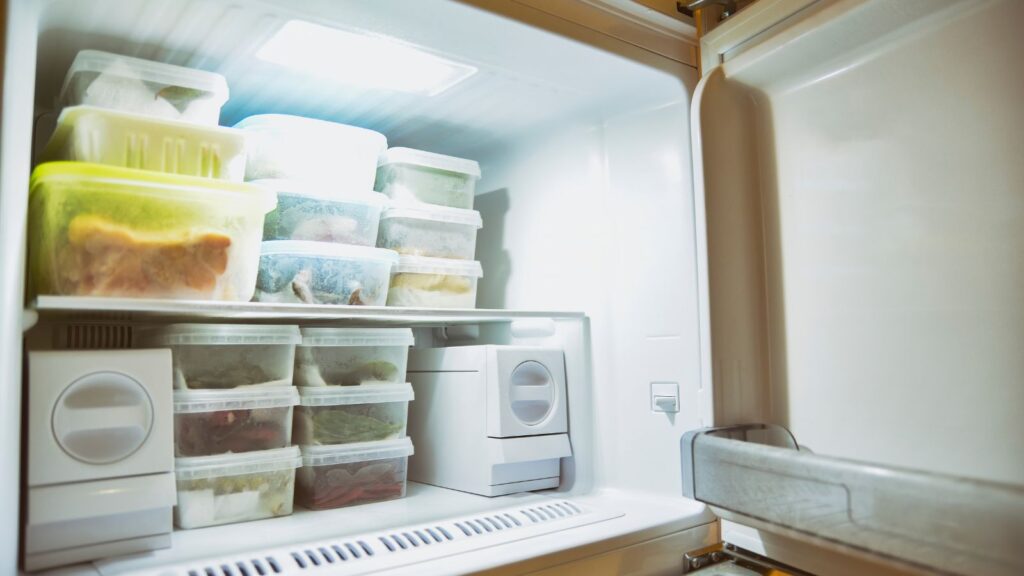In today’s fast-paced world, Safe food preservation at home has become an increasingly popular and eco-friendly option for many. Not only does it help reduce food waste, but it also allows you to enjoy seasonal foods year-round without breaking the bank.
In this blog post, we’ll explore 5 safe techniques for preserving food at home: canning, freezing, drying, fermenting, and pickling.
Key Takeaways
- Preserving food at home is eco-friendly and can reduce food waste, provide access to seasonal produce year-round, save money on groceries, and allow for customized flavors and ingredients.
- The 5 safe techniques for preserving food at home are canning (water bath and pressure canning), freezing, drying, fermenting, and pickling.
- Each preservation method has its own requirements in terms of equipment and preparation. It’s essential to follow tested recipes that have been researched by reliable sources such as the USDA or the National Center for Home Food Preservation to ensure safe preservation when canning at home.
- By utilizing these safe preservation methods off – grid living enthusiasts could enjoy their garden harvests all year round while minimizing their carbon footprint through reducing plastic packaging waste and supporting local farming communities.
Why Preserving Food At Home Is Important
Preserving food at home is important because it helps reduce food waste, provides access to seasonal produce year-round, saves money on groceries, and offers the ability to customize flavors and ingredients.
Reducing Food Waste
One of the significant benefits of practicing home food preservation is its positive impact on reducing food waste. In the United States, approximately 30 to 40 percent of all food produced goes uneaten, often due to spoilage or over-purchasing.
For example, fruits that are beginning to turn soft and vegetables nearing their expiry date can be quickly transformed into delicious jams, canned tomatoes for soups and sauces, or even dried into healthy snacks instead of being discarded.
Moreover, embracing these home preservation methods enables off-grid living enthusiasts to create a sustainable pantry filled with nutritious options that last longer without relying on store-bought processed goods – further helping our environment by reducing plastic packaging waste and supporting local farming communities.
Access To Seasonal Foods
Preserving food at home offers individuals access to seasonal foods all year round. For those living off the grid, this can be particularly useful in ensuring a steady supply of fresh produce throughout the year.
By preserving fruits and vegetables when they are in season, you can enjoy them even during months when they are not typically available. Not only does this offer a wider variety of foods but it also ensures that you have access to nutritious food regardless of where you live or what time of year it is.
Home preservation techniques such as canning, freezing, drying, fermenting and pickling all provide an accessible way to preserve seasonal foods with minimal effort while maintaining their nutritional value.
Saving Money
Preserving food at home can be a great way to save money on groceries. By buying fresh produce in bulk during harvest season and preserving it for later use, individuals can avoid the high cost of out-of-season fruits and vegetables.
For example, instead of paying top dollar for out-of-season strawberries in the winter months, you could buy them at a lower price during their peak season and preserve them through methods such as freezing or canning.
In addition to saving money on produce costs, homemade preserved foods also eliminate the need for expensive processed foods or pre-packaged meals.
Customized Flavors And Ingredients
Another benefit of preserving food at home is having the ability to customize flavors and ingredients. When canning or pickling, individuals can experiment with different spices and seasonings to create unique blends that cater to their taste preferences.
For example, adding garlic cloves or red pepper flakes to pickled cucumbers can give them a spicy kick, while adding herbs like rosemary or thyme to canned tomatoes can enhance their flavor profile.
Additionally, by preserving seasonal produce at its peak freshness, individuals can take advantage of the unique flavors and textures that come with each harvest. This allows for a wider variety of ingredients in cooking as well as reducing waste by using up excess produce before it spoils.
Understanding Food Preservation Techniques And Methods
Food preservation techniques include cool temperature storage, food drying, canning (water bath and pressure canning), and freezing.
Cool Temperature Storage
Cool temperature storage is one of the simplest and most effective methods for preserving food at home. This method involves storing food at a cool temperature, which helps slow down the growth of bacteria and prevents spoilage.
Another way to use cool temperature storage is by using a pantry or cupboard in your home that stays relatively cool. You can store foods like canned goods, dried fruits and nuts, and even fresh produce that does not require refrigeration such as apples or citrus fruit.
Food Drying
Food drying is a preservation method that has been used for centuries and involves removing moisture from food to prevent spoilage. This technique can be done using either a dehydrator or the sun, depending on the type of food being preserved.
Fruits, vegetables, herbs, and meat are all excellent candidates for food drying as they tend to have higher water content. Drying foods also allows you to enjoy them year-round instead of only during specific seasons.
For instance, dried tomatoes can be used in stews or salads while dried apples make excellent snacks.
Canning: Water Bath And Pressure Canning
Canning is a popular preservation method that involves using a water bath or pressure canner to kill bacteria while sealing the food in jars. Water bath canning is suitable for high-acid foods like fruits, pickles, jellies, and jams.
You’ll need a large pot with enough room to submerge your jars of food fully. Bring water to a boil while preparing the food and filling sterilized jars with it before immersing them in boiling water for processing times specified in recipes.
Pressure canning, on the other hand, is necessary for low-acid foods such as vegetables, meats, fish, and poultry.
If you’re living off-grid or don’t have access to electricity consistently needed by some types of pressure canners (electricity-powered), investing in manual models may be more realistic although they take longer time processing compared to electric ones being precise at temperature regulation thereby ensuring safe home canned products for consumption at all times.
Freezing Foods

Freezing is a simple and effective way to preserve food at home. It involves storing food in your freezer until you’re ready to use it. Freezing is particularly useful for fruits, vegetables, meats, and baked goods like bread or pastries.
This method of preservation works by slowing down the growth of microorganisms that cause spoilage.
To freeze food properly, start by washing and preparing the item as you normally would. Then package it in an appropriate container or bag designed for freezing, making sure to remove as much air as possible before sealing it shut.
Label each package with the date so you know when you put it in the freezer.
By freezing seasonal produce when it’s abundant or buying items on sale, off-grid living enthusiasts can have access to fresh ingredients all year round while saving money and reducing waste at the same time!
5 Safe Techniques For Preserving Food At Home
Here are 5 safe techniques for preserving food at home: canning, freezing, drying, fermenting, and pickling.
1. Canning
Canning is a popular preservation method that involves cooking food in jars and sealing them to prevent bacteria from entering. There are two types of canning methods: water bath canning, which is used for high acid foods like fruits, jams, and pickles; and pressure canning, which is necessary for low acid foods like meat, vegetables, beans, and soups.
To ensure safe preservation when canning at home, it’s important to follow tested recipes that have been researched by reliable sources such as the USDA or the National Center for Home Food Preservation.
It’s also essential to use proper equipment like a pressure canner or a boiling water bath to achieve the right temperature and seal on your jars.
2. Freezing
Freezing is a simple and easy method of preserving food that can be done in any home. By freezing food, it can be kept fresh for an extended period without the use of chemicals or preservatives.
For off-grid living, freezing is particularly convenient as it doesn’t require any special equipment except for a freezer.
To freeze foods safely at home, make sure they are clean and dry before placing them in a freezer-safe container or bag. Be sure to label each item with its name and date so you know when it was frozen.
When thawing out frozen foods, do not leave them at room temperature for more than two hours to avoid bacterial growth.
By freezing excess produce from your garden harvests or buying products on sale during peak seasons and storing them in your freezer; you can cut down on waste while maintaining access to seasonal ingredients all year round.
3. Drying
Drying is one of the oldest methods of food preservation. It involves removing moisture from food, making it less susceptible to bacterial growth and spoilage. Dried fruits, vegetables, and herbs can be easily stored for long periods without losing their nutritional value or flavor.
There are different ways to dry foods at home, including using a dehydrator or oven or air-drying in the sun. One example of drying food is making beef jerky by cutting thin pieces of meat before marinating them in a mixture of spices and then drying them slowly until they have been fully dehydrated.
4. Fermenting
Another safe technique for preserving food at home is fermenting. Fermenting involves the use of beneficial microorganisms to preserve food, enhance its flavor, and increase its nutritional value.
Fermentation occurs when naturally occurring bacteria break down the sugars in a food item, creating acid that stops other harmful bacteria from growing. The process also produces gases that cause bubbles to form in the fermented product.
Fermented foods offer numerous health benefits because they contain probiotics which help promote good gut health by balancing out digestive flora. They are also rich in vitamins B and C which aid digestion and boost immunity respectively.
5. Pickling
Pickling is a popular food preservation technique that involves using vinegar or brine to preserve and flavor fruits, vegetables, and even meats. This method works by creating an acidic environment that prevents the growth of bacteria and other microorganisms that can cause spoilage.
Pickled foods are great for off-grid living because they do not require refrigeration and can be stored for long periods.
Examples of pickled foods include cucumbers (commonly known as pickles), jalapenos, carrots, onions, garlic, cabbage (in the form of sauerkraut), beets, eggs, and even fish.
The flavors of these pickled foods vary depending on the spices and herbs used in the brine or vinegar mixture.
Proper hygiene when preparing pickles is important to prevent contamination with harmful bacteria such as botulism; adding salt to your recipe will help protect against this possibility.
Tips For Safe Food Preservation
Use proper equipment and follow recommended recipes to ensure safe food preservation.
Using Proper Equipment And Techniques
When it comes to preserving food at home, using proper equipment and techniques is crucial for ensuring safe results. One of the most important pieces of equipment when canning food is a pressure canner, which is essential for safely canning low-acid foods like vegetables, meats, and poultry.
In addition to using proper equipment, following recommended recipes and guidelines is key. There are many tested recipes available from reputable sources like the USDA and National Center for Home Food Preservation that provide step-by-step instructions on how to properly preserve different types of foods.
Practicing good hygiene and cleanliness while handling food also helps minimize risk of contamination.
Following Recommended Recipes And Guidelines
It is crucial to follow recommended recipes and guidelines when preserving food at home. These recipes have been tested for safety, and following them ensures that your food will be preserved properly.
This can help prevent harmful bacteria like botulism from growing in your preserved foods.
To ensure you are using safe techniques when preserving food at home, consider taking a class or workshop on food preservation. The University Extension Office often offers classes that teach proper techniques for drying fruits and vegetables or pressure canning low-acid foods.
Another useful resource is the National Center for Home Food Preservation website, which has tested recipes for all methods of preservation and detailed instructions on how to safely preserve different types of food items.
Practicing Good Hygiene And Cleanliness
It’s important to maintain good hygiene and cleanliness when preserving food at home. This involves washing your hands thoroughly before handling any food, using clean utensils and equipment, and sterilizing jars or containers before filling them.
Additionally, labeling all preserved foods with the type of food, date of preservation, and any special instructions can help you identify them easily later on. Before consuming any preserved food months after preserving it for example canned fruits that didn’t get consumed up within 48 hours after opening should be discarded if they show signs of spoilage such as off-odors, discoloration (might appear brownish), molds growing in the jar’s content or lid bulges among others .
Keeping a close eye on your preserved foods’ appearance and smell will also alert you to any potential spoilage issues early enough.
Labeling And Dating All Preserved Foods
Once you’ve gone through the hard work of preserving your food, it’s essential to label and date everything correctly. This step may seem small, but it is vital for keeping track of what you have on hand and making sure that you use everything before it goes bad.
Put a date on each jar or package so that you know how long they’ve been sitting in storage and can take appropriate action if necessary. Also, write down what’s inside the container and any additional notes such as “spicy pickles” or “low-sugar jam.” This labeling will come in handy when planning meals or grabbing something quick from storage.
Identifying Signs Of Spoilage
It is essential to know the signs of spoilage when preserving food at home. Signs of spoilage can include bad odor, mold growth, slimy texture, discoloration, and bubbling liquid in canned foods.
Inspect preserved foods before consumption regularly and discard any that show signs of spoilage or have damaged lids.
To prevent spoilage, always store your preserved food in a clean area away from direct sunlight, heat sources or freezing temperatures unless specifically required for certain methods such as freezing or cold temperature storage.
Remembering to label and date all jars with proper information including which recipe was used will help keep track of how long various foods are stored so they can be consumed within safe time limits.
Using good hygiene practices during preservation is also important in preventing contamination by bacteria or other microorganisms that could cause illness if ingested.
Using Preserved Foods In Meals
Preserved foods can be used in a variety of meals, such as canned vegetables and fruits for salads or soups, pickled cucumbers and carrots for sandwiches, dried herbs for seasoning dishes, fermented vegetables for side dishes or condiments, and frozen meat or fish for main courses.
Recipe Ideas For Canned, Frozen, Dried, Fermented, And Pickled Foods
Preserved foods are not only great for emergency supplies but can also become delicious ingredients in your everyday meals. Canned tomatoes and pickled cucumbers add zing to sandwiches, while dried fruits make for a nutritious snack.
Frozen vegetables are perfect for soups or stews, and fermented vegetables like sauerkraut or kimchi bring tangy flavors to any dish.
Try using canned peaches in pancakes or muffins, adding rehydrated sun-dried tomatoes to pastas, incorporating fermented carrots into sandwiches, or creating a colorful salad with pickled beets.
The possibilities are endless when it comes to using preserved foods creatively in the kitchen.
Conclusion
In conclusion, preserving food at home is a great way to reduce food waste and save money while enjoying fresh seasonal flavors year-round. By understanding the various safe preservation techniques and following recommended recipes and guidelines, you can keep your food safe and delicious for longer periods of time.
FAQs:
1. What are the 5 safe techniques for preserving food at home?
The 5 safe techniques for preserving food at home include canning, freezing, dehydrating, pickling and fermenting.
2. Are there any safety precautions I should take when preserving food?
Yes, it is important to follow proper hygiene practices such as washing your hands before handling food and sterilizing all equipment used in the process. Additionally, it is critical to use tested recipes specifically designed for each method of preservation to ensure that bacteria growth is inhibited.
3. How long can preserved foods be safely stored?
This varies depending upon the type of preservation method used – canned goods can typically last up to two years if stored properly in a cool, dry place while frozen items can remain safe indefinitely as long as they’re protected from freezer burn which results due moisture loss or exposure air.
4. Can any type of food be preserved using these methods?
While many types of foods may be preserved using these methods including fruits and vegetables – some may not hold up as well under certain conditions due varying levels acidity & sugar content etc altogether affecting its overall shelf life expectancy post-preservation.




